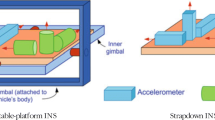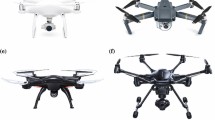Abstract
A robust unscented Kalman filter based on a multiplicative quaternion-error approach is proposed for nanosat estimation in the presence of measurement faults. The global attitude parameterization is given by a quaternion, while the local attitude error is defined using a generalized three-dimensional attitude representation. The proposed algorithm uses a statistical function including measurement residuals to detect measurement faults and then uses an adaptation scheme based on multiple measurement scale factor for filter robustness against faulty measurements. The proposed algorithm is demonstrated for the attitude estimation of a nanosat with an on-board three-axis magnetometer and rate-integrating gyros in the presence of measurement faults as well as satellite orbit errors. To compare the estimation performance of the proposed algorithm, the robust unscented Kalman filter with single measurement noise scale factor, the standard extended Kalman filter and the unscented Kalman filter are also implemented under the same simulation conditions.
Similar content being viewed by others
References
J. Cote and J. D. Lafontaine, “Magnetic-Only Orbit and Attitude Estimation Using the Square-Root Unscented Kalman Filter: Application to the PROBA-2 Spacecraft,” AIAA Guidance, Navigation and Control Conference and Exhibit, Honolulu, Hawaii, USA, pp. 1–24, 2008.
J. R. Wertz, Spacecraft Attitude Determination and Control, Springer Science and Business Media, D. Reidel Publishing Company, The Netherlands, p. Ch.19, 1978.
F. L. Markley and J. L. Crassidis, Fundamentals of Spacecraft Attitude Determination and Control, Microcosm Press and Springer, New York Heidelberg Dordrecht London„ p. Ch. 3 and 4 2014.
S. F. Schmidt, “The Kalman Filter: Its Recognition and Development for Aerospace Applications,” Journal of Guidance, Control, and Dynamics, vol. 4, no. 1, pp. 4–7, 1981. [click]
E. Lefferts, F. Markley, and M. Shuster, “Kalman Filtering for Spacecraft Attitude Estimation,” Journal of Guidance, Control, and Dynamics, vol. 5, no. 5, pp. 417–429, 1982. [click]
D.-J. Jwo and H.-C. Huang, “Neural Network Aided Adaptive Extended Kalman Filtering Approach for DGPS Positioning,” Journal of Navigation, vol. 57, no. 3, pp. 449–463., 2004 [click]
D. Won, J. Ahn, S. Sung, M. Heo, S.-H. Im, and Y. J. Lee, “Performance Improvement of Inertial Navigation System by Using Magnetometer with Vehicle Dynamic Constraints,” Abstract and Applied Analysis, vol. 2015, pp. 1–11, 2015.
H. E. Soken, C. Hajiyev, and S. Ichiro Sakai, “Pico Satellite Attitude Estimation via Robust Unscented Kalman Filter in the Presence of Measurement Faults,” European Journal of Control, vol. 20, no. 2, pp. 64–72, 2014.
R. Havangi, “Robust SLAM: SLAM base on H ∞ square root unscented Kalman filter,” Nonlinear Dynamics, vol. 83, no. 1, pp. 767–779, 2016.
E. Lee, S. Chun, Y. J. Lee, T. Kang, G.-I. Jee, and J. Kim, “Parameter Estimation for Multipath Error in GPS Dual Frequency Carrier Phase Measurements Using Unscented Kalman Filters,” International Journal of Control, Automation, and Systems, vol. 5, no. 4, pp. 388–396, 2007.
S. J. Julier, “The Scaled Unscented Transformation,” American Automatic Control Council, Evanston, IL, pp. 1108–1114, 2002.
E. A. Wan and R. van der Menve, “The Unscented Kalman Filter for Nonlinear Estimation,” Adaptive Systems for Signal Processing, Communications, and Control Symposium 2000, pp. 153–158, 2000.
H. M. T. Menegaz, J. Ishihara, G. A. Borges, and A. N. Vargas, “Systematization of the Unscented Kalman Filter theory,” IEEE Transactions on Automatic Control, vol. 60, no. 10, 2015, pp. 2583–2598. [click]
J. L. Crassidis and F. L. Markley, “Unscented Filtering for Spacecraft Attitude Estimation,” Journal of Guidance, Control, and Dynamics, vol. 26, no. 4, pp. 536–542, 2003. [click]
Y. Xing, S. Zhang, J. Zhang, and X. Cao, “Robust-extended Kalman filter for small satellite attitude estimation in the presence of measurement uncertainties and faults,” Proceedings of the Institution of Mechanical Engineers, Part G: Journal of Aerospace Engineering, vol. 226, no. 1, pp. 30–41, 2012.
Soken, H. E. and Hajiyev, C., “Pico Satellite Attitude Estimation via Robust Unscented Kalman Filter in the Presence of Measurement Faults,” ISA Transactions, vol. 49, no. 3, pp. 249–256, 2010.
C. Hajiyev and H. E. Soken, “Robust Adaptive Unscented Kalman Filter for Attitude Estimation of Pico Satellites,” International Journal of Adaptive Control and Signal Processing, vol. 28, no. 2, pp. 107–120, 2014. [click]
C. Hajiyev and H. E. Soken, “Robust Adaptive Kalman Filter for Estimation of UAV Dynamics in the Presence of Sensor/Actuator Faults,” European Journal of Control, vol. 28, no. 1, pp. 376–383, 2013.
M. Shuster, “Kalman Filtering for Spacecraft Attitude Estimation,” Journal of the Astronautical Science, vol. 41, no. 4, pp. 439–517, 1993.
Schaub, H. and Junkins, J. L., “Stereographic orientation parameters for attitude dynamics: A generalization of the Rodrigues parameters,” Journal of the Astronautical Sciences, vol. 1, no. 44, pp. 1–20, 1996.
H. Schaub and J. L. Junkins, Analytical Mechanics of Space Systems, American Institute of Aeronautics and Astronautics, Reston, VA, 2nd ed., pp. 88–192, 2009.
G. Avanzini and F. Giulietti, “Magnetic Detumbling of a Rigid Spacecraft,” Journal of Guidance, Control, and Dynamics, vol. 35, no. 4, pp. 1326–1334, 2012. [click]
H. B.Hablani, “Comparative Stability Analysis and Performance of Magnetic Controllers for Bias Momentum Satellites,” Journal of Guidance, Control, and Dynamics, vol. 18, no. 6, pp. 1313–1320, 1995. [click]
“Analytical Graphics. INC., The Simplified General Perturbations (SGP4) propagator,” https://www.agi. com/resources/educational-alliance-program/astroprimer/ primer106.htm, Accessed: 2015-09-15.
“Analytical Graphics. INC., the High Precision Orbit Propagator (HPOP),” https://www.agi. com/resources/educational-alliance-program/astroprimer/ primer107.htm, Accessed: 2015-09-15.
R. L. Farrenkopf, “Analytic Steady-State Accuracy Solutions for Two Common Spacecraft Attitude Estimators,” Journal of Guidance, Control, and Dynamics, vol. 1, no. 4, pp. 282–284, 1978.
F. L. Markley, “Attitude Error Representations for Kalman Filtering,” Journal of Guidance, Control, and Dynamics, vol. 26, no. 2, pp. 311–317, 2003. [click]
E. A. Wan and R. van der Merwe, Kalman Filtering and Neural Networks, JohnWiley & Sons, edited by S. Haykin, Ch. 7, New York, NY, 2001.
Author information
Authors and Affiliations
Corresponding author
Additional information
Recommended by Associate Editor Yang Tang under the direction of Editor Hamid Reza Karimi.
Daero Lee is a postdoctoral research fellow in the department of Earth and Space Science and Engineering at York University, Toronto, Ontario Canada. He received the B.A. and M.S. in aerospace engineering from Konkuk University, Seoul, Korea, in 1999 and 2001, respectively. He received another M.S. in aerospace engineering from Auburn University in 2006. He received the Ph.D. in aerospace engineering from Missouri University of Science and Technology in 2009. His research interests are spacecraft dynamics, control and navigation for (asteroid explorations, spacecraft formation flying, and rendezvous and docking, cubetsat mission), geometric/algebraic methods applied to nonlinear systems, and GNSS/INS integration.
George Vukovich Following his Ph.D. from the University of Toronto in Aerospace and Control Systems Dr Vukovich was employed at Dynacon Enterprises LTD in spacecraft control system design. He then worked as a research engineer for both Northrop Corp and Honeywell Inc, in navigation and guidance systems, and then went on to be a research scientist at the Canadian Space Agency in St Hubert Quebec. In 1996 he became Director of Spacecraft Engineering at the CSA, a position he held until 2010, becoming a scientist once again. In 2012 he joined the Lassonde School of Engineering at York University in Toronto where his current research interests are spacecraft control systems, solar and electric sail spacecraft, robotics, and smart structures.
Regina Lee is Associate Professor and Chair of the Department of Earth and Space Science and Engineering at York University, Toronto, Canada where she has been since 2007. Prof. Lee received a B.A.Sc. (Engineering Science) in 1994 and M.A.Sc in 1995 from the University of Toronto. She received her Ph.D. from the University of Toronto in 2000. From 2000 to 2007 she worked at Dynacon Inc. as a (NSERC) industry post-doctoral fellow, and later as a Research Scientist. Prof. Lee’s research interests center on nanosatellite technology development. It has been a focus of Prof. Lee’s research at York to develop a series of space technologies that will lead to scientific nanosatellite missions in the near future. Currently, she is investigating several areas including micro-spectrometer design, micro-propulsion system, MEMS based attitude sensors and actuators and algorithms to incorporate their low-grade characteristics; and examination of field-programmable gate array (FPGA)- based subsystem development.
Rights and permissions
About this article
Cite this article
Lee, D., Vukovich, G. & Lee, R. Robust unscented Kalman filter for nanosat attitude estimation. Int. J. Control Autom. Syst. 15, 2161–2173 (2017). https://doi.org/10.1007/s12555-016-0498-4
Received:
Revised:
Accepted:
Published:
Issue Date:
DOI: https://doi.org/10.1007/s12555-016-0498-4




